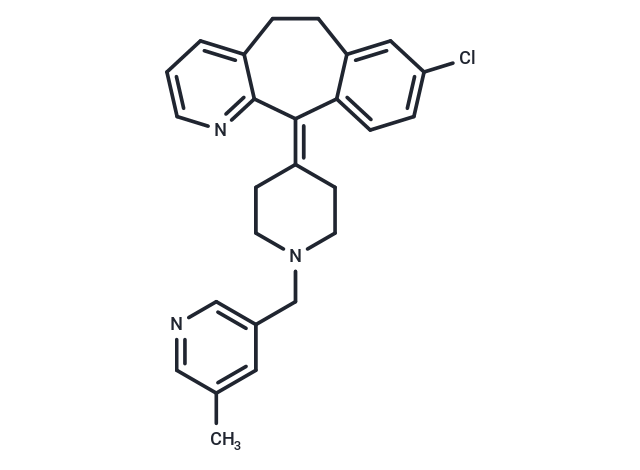Shopping Cart
- Remove All
 Your shopping cart is currently empty
Your shopping cart is currently empty

Rupatadine (UR-12592) is a potent dual PAF/H1 antagonist with Ki values of 0.55 μM in rabbit platelet membranes and 0.1 μM in guinea pig cerebellum membranes.

| Pack Size | Price | Availability | Quantity |
|---|---|---|---|
| 5 mg | $970 | 7-10 days |
| Description | Rupatadine (UR-12592) is a potent dual PAF/H1 antagonist with Ki values of 0.55 μM in rabbit platelet membranes and 0.1 μM in guinea pig cerebellum membranes. |
| Targets&IC50 | PAF:0.55 μM (Ki), H1 receptor:0.1 μM (Ki) |
| In vitro | Target: PAF/H1 antagonist. Rupatadine competitively inhibited histamine-induced guinea pig ileum contraction (pA2 = 9.29 +/- 0.06) without affecting contraction induced by ACh, serotonin or leukotriene D4 (LTD4). It also competitively inhibited PAF-induced platelet aggregation in washed rabbit platelets (WRP) (pA2 = 6.68 +/- 0.08) and in human platelet-rich plasma (HPRP) (IC50 = 0.68 microM), while not affecting ADP- or arachidonic acid-induced platelet aggregation [1]. The IC50 for rupatadine in A23187, concanavalin A and anti-IgE induced histamine release was 0.7+/-0.4 microM, 3.2+/-0.7 microM and 1.5+/-0.4 microM, respectively whereas for loratadine the IC50 was 2.1+/-0.9 microM, 4.0+/-1.3 M and 1.7+/-0.5 microM. SR-27417A exhibited no inhibitory effect [2]. |
| In vivo | Rupatadine blocked histamine- and PAF-induced effects in vivo, such as hypotension in rats (ID50 = 1.4 and 0.44 mg/kg i.v., respectively) and bronchoconstriction in guinea pigs (ID50 = 113 and 9.6 micrograms/kg i.v.). Moreover, it potently inhibited PAF-induced mortality in mice (ID50 = 0.31 and 3.0 mg/kg i.v. and p.o., respectively) and endotoxin-induced mortality in mice and rats (ID50 = 1.6 and 0.66 mg/kg i.v.) [1]. rupatadine treatment improved the declined lung function and significantly decreased animal death. Moreover, rupatadine was able not only to attenuate silica-induced silicosis but also to produce a superior therapeutic efficacy compared to pirfenidone, histamine H1 antagonist loratadine, or PAF antagonist CV-3988 [3]. |
| Molecular Weight | 415.96 |
| Formula | C26H26ClN3 |
| Cas No. | 158876-82-5 |
| Storage | Powder: -20°C for 3 years | In solvent: -80°C for 1 year | Shipping with blue ice. |
| Solubility Information | DMSO: Soluble |

Copyright © 2015-2025 TargetMol Chemicals Inc. All Rights Reserved.